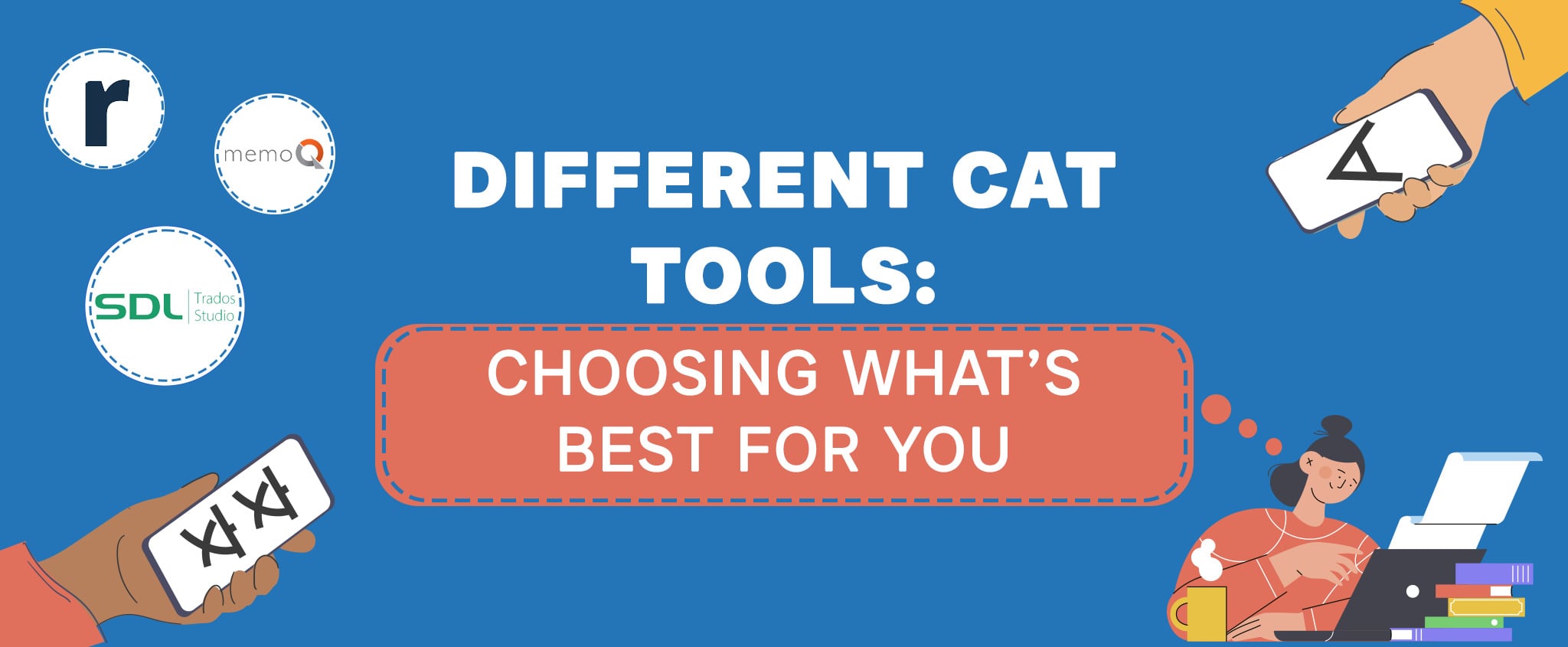Different CAT Tools : Choosing What’s Best for You
In the dynamic world of translation, Computer Assisted Translation (CAT) tools have emerged as game-changers, providing high efficiency, consistency, and productivity for translators. While nothing still beats the human brain in translation, computer-assisted translation tools have become essential in the field. But with many CAT tools on the market, making the right choice can be overwhelming. CCC International sheds light on choosing the best CAT tools for your language needs!
Key Takeaways:
- The computer-assisted translation meaning is the use of technology to aid human translators in their work.
- Unlike machine translation and AI-assisted translation, computer-assisted translation tools or CAT tools don’t replace human translators but rather aid in translation.
- The best CAT tools depend on individual needs and preferences.
Table of Contents:
- What Is Computer-Assisted Translation?
- The Top Tools for CAT
- How to Choose the Best CAT Tool
- CCCI – Professional Translation Services
What Is Computer-Assisted Translation?
When we talk about computer-assisted translation meaning, we’re referring to the process of translating texts using specialized software. Unlike machine translation and AI-assisted translation, which rely primarily on machine learning and algorithms, the human translator essentially remains in control in CAT, and the software only assists in various aspects of the process.
In 2022, the worldwide market for language services stands at an impressive valuation of USD 60.68 billion. With globalization, businesses are expanding their reach to new markets and must communicate with customers who don’t speak their language. How does CAT help in this scenario?
CAT can significantly speed up the translation process by automating repetitive tasks. These tools also have Translation Memory (TM) that stores previously translated sentences or phrases and built-in quality assurance mechanisms that help maintain high-quality translations and often facilitate real-time collaboration among translators.
Pro Tip: Human translators remain crucial for refining and polishing translations that use CAT tools. Like any other tool, CAT is only as good as its input, so the quality of the translation depends on the translator’s skills and proficiency.
The Top Tools for CAT
Selecting the right tool can significantly influence your productivity and output quality. Among all the tools available, which are the best you could consider?
Redokun
Redokun is a standout choice because it offers a user-friendly interface that requires minimal training. The tool also allows you to organize and manage your project files, and its seamless collaboration and import and export features are unbeatable. Redokun offers smart revisions for quick and last-minute changes to your original document. Its responsive support team completes the package, making it an all-inclusive translation tool.
SDL Trados Studio
SDL Trados Studio is another industry-leading CAT tool that deserves considerable mention. This comprehensive solution caters to translators, editors, and project managers’ needs. Trados Studio prides itself on its advanced translation memory technology, which allows for significant time savings. The tool also offers a variety of innovative features like terminology management, machine translation, and automated quality checks. Its integration capabilities with other software and platforms further enhance its appeal.
memoQ translator pro
memoQ translator pro is another top-tier CAT tool that has earned a strong reputation within the translation industry. Translators designed this tool to significantly enhance performance, edit, and review translations more efficiently, providing project templates and a live preview to ensure accuracy and consistency in translation. The package includes free support and maintenance for one year, further solidifying its position as a reliable CAT tool.
Note: memoQ translator pro runs exclusively on Microsoft Windows. To unlock its complete translation management and collaboration capabilities, users must connect to the memoQ server.
How to Choose the Best CAT Tool
Choosing the best CAT tool is about finding the one that fits your individual needs or the specific requirements of your translation project. Here are some steps to consider in your decision-making process:
Determine Your Specific Translation Needs
Your decision will largely depend on the translation tasks you must handle. Some are better suited for technical translations, while others excel in literary translations. Identify the nature of your translation work to narrow down your search.
Look for Collaboration Features
Another crucial factor is collaboration with other team members, clients, or service providers. This feature becomes even more critical when working with a remote team, where real-time communication and document sharing play a significant role.
Check Compatibility with File Formats
The best CAT tool for you should support the file formats you typically work with. Check whether the software accepts and exports your preferred formats to ensure seamless operation.
Consider Budget and Pricing Models
Different tools come with varying pricing models. Some are one-time purchases, while others follow a subscription-based model. Determine your budget and consider the cost-effectiveness of the tool in the long run.
Assess the Learning Curve
Like any other software, CAT has a learning curve. Some tools may have a more user-friendly interface or offer comprehensive tutorials, aiding in quicker mastery.
Pro Tip: Some tools are pricier than others and require steep learning curves because of their advanced features. If you’re new to the technology, consider trying out a free or low-cost tool first with basic features to get familiar with the concept.
Look at Integration Capabilities
Check whether the tool can integrate with other relevant software or tools you use. Seamless integration is crucial for efficient workflow.
Read User Reviews and Feedback
Last but not least, consider the experiences of other users. User reviews, testimonials, and feedback can offer invaluable insights into a tool’s performance, reliability, and user satisfaction.
CCCI – Professional Translation Services
Redokun, SDL Trados Studio, and memoQ translator pro are just three of the many CAT tools on the market. Developers continue to improve and innovate their products, providing users with better and more efficient tools. In the end, the best CAT tool is the one that best aligns with your needs, preferences, and budget.
At CCCI, we understand the importance of using CAT in our specialized translation services. Our team combines data collection, automation, and human expertise when using tools to ensure accuracy, consistency, and faster turnaround times. We pride ourselves on our professionalism, efficiency, and commitment to quality.
When bringing your business or project to a global audience, don’t leave it up to chance. Trust CCCI and our professional translation services, backed by the latest CAT technologies, to help you communicate your message effectively and accurately. Contact us today!






